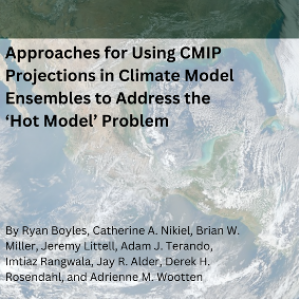New Publication: Approaches for Using CMIP Projections in Climate Model Ensembles to Address the ‘Hot Model’ Problem
Date
Authors: Ryan Boyles, Catherine A. Nikiel, Brian W. Miller, Jeremy Littell, Adam J. Terando, Imtiaz Rangwala, Jay R. Alder, Derek H. Rosendahl, and Adrienne M. Wootten.
What is the ‘Hot Model’ problem?
Due to the complexity of Earth’s systems, it is difficult for models to accurately assess and project the interconnected factors that contribute to climate warming. Certain models, when used to model past and future climate, have been shown to have “anomalously high” sensitivities to atmospheric greenhouse gasses, i.e, they project climate warming that is much higher than other evidence suggests. Metrics such as equilibrium climate sensitivity (ECS) and transient climate response (TCR) are often used to quantify the effects of atmospheric greenhouse gas concentrations on Earth’s surface temperature. Models with a high ECS and TCR project higher warming, both globally and regionally, than models with a lower ECS and TCR. The “Hot Model” problem is much more common in the most recent version of climate models compiled through the Coupled Model Intercomparison Project Phase-6 (CMIP6) effort.
Approaches for Using CMIP Projections in Climate Model Ensembles
Authors note that, compared to previous versions, models from CMIP6 improve on representations of global-scale physical, chemical, and biological processes at a higher spatial resolution. They discuss different approaches which could be adopted by practitioners, based on their risk tolerance, to work with CMIP6 projections. These include an all models approach, ECS and TCR screening, Bayesian Model Averaging, and global warming levels. They also provide an example for considering each approach in a case study of a “climate risk assessment for an imaginary at-risk species - the golden-billed raptor” (Boyles et al., 2024).
Authors point out that most downscaled-climate projections (including derived datasets) and decision-support tools are currently available largely for CMIP5 models, and therefore those datasets and tools remain useful for many resource-management applications until similar capabilities are developed and made available for CMIP6 projections.
Recommendations for Selecting Models
Choosing the right model depends on the risk tolerance and management context, as well as the location, objectives, and system focus of the application. The authors do not offer a definitive universal approach to this question, instead suggesting that multiple models and projections, utilizing multiple-emissions scenarios and multiple models per scenario, should be used to “capture a range of possible future conditions” (Boyles et al., 2024).
Reference
Boyles, R., Nikiel, C.A., Miller, B.W., Littell, J., Terando, A.J., Rangwala, I., Alder, J.R., Rosendahl, D.H., and Wootten, A.M., 2024, Approaches for using CMIP projections in climate model ensembles to address the ‘hot model’ problem: U.S. Geological Survey Open-File Report 2024–1008, 14 p., https://doi.org/10.3133/ofr20241008.
Read the publication here!


